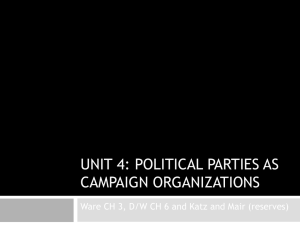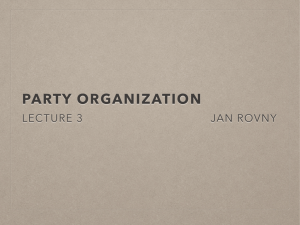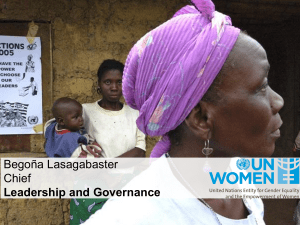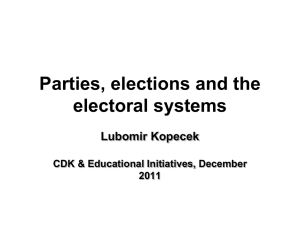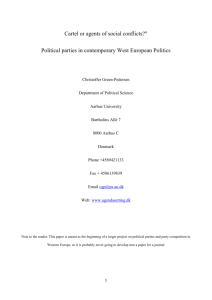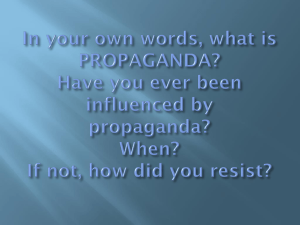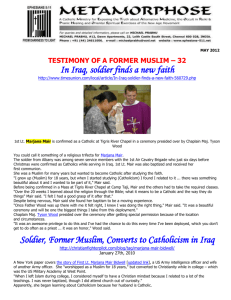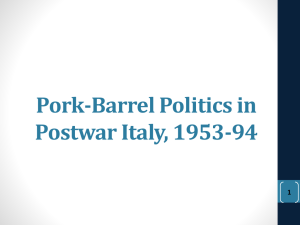Unit 4: Political Parties and Organization
advertisement
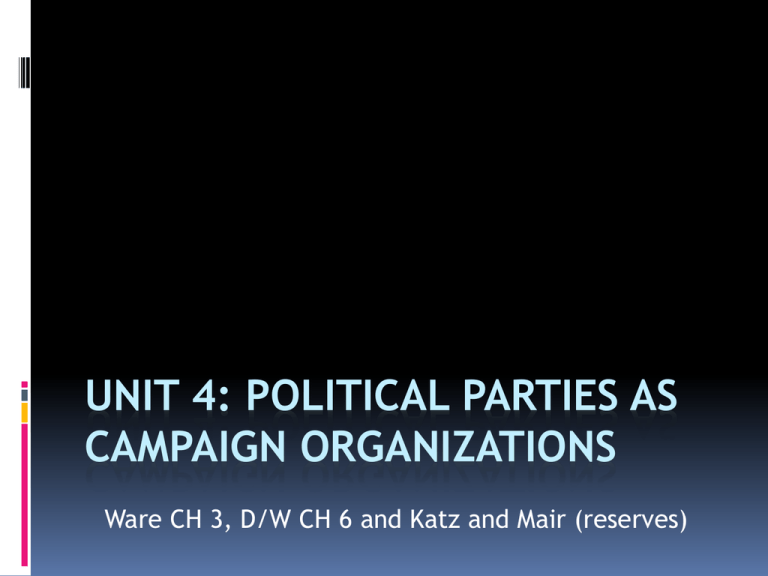
UNIT 4: POLITICAL PARTIES AS CAMPAIGN ORGANIZATIONS Ware CH 3, D/W CH 6 and Katz and Mair (reserves) Guiding Questions What are cartel parties? How do they differ from cadre, mass, and catch all parties? How does electoral politics play into the politics of cartel parties? What Do Parties Organizations Do? Ware 1996 Party organizations: Organize campaigns and elections Maintain or build the party membership base Determine policies/strategies for office holders. But the emphasis that a specific party places on these functions varies Developing new policies is often the least tended to area of organizational influence Particularly amongst parties in opposition Advances in technology have privileged the electoral functions of party organization over other functions. Elections and Party Organization Duverger 1956, Epstein 1967 Electoral considerations prompts changes in organizations. Contagion from the left mass parties/Contagion from the right catch-all parties Panebianco 1988 Professionalization of politics pushes emphasis away from party membership towards political professionals in the waging of campaigns. Push towards electoral-professional parties. Consequences of Professionalization Shift in staffing from local branches to central party offices. Central party is dominant Elections driven by party leader (i.e. presidentialization). Political consultancy has become a major growth industry “Marketing” parties is key. Mimicry amongst political parties adapting to new technologies. Example: Republicans/Democrats on GOTV, Facebook, Twitter Public financing of campaigns has shaped the list of contenders in a much more expensive political world. Some “outside” parties still jump these hurdles. Mass Parties, Catch-All Parties, and Linkages to Society Why does this shift towards electoral politics matter? Party research has focused on relationships between parties and society. Neumann 1956 Mass parties served as political structures which integrated citizens into political societies. Kirchheimer 1966 Bemoans the demise of mass parties. Posits that the switch the catch all parties is problematic from a societal standpoint. Katz and Mair 1997 Argue that this research ignores relationship between parties and the state. Modern relationships between parties, society and the state do not sustain mass parties. Elections are fought over issues of competence and management rather than group belonging or identity. Parties, Civil Society, and the State Katz and Mair 1997 Cadre: State/society interpenetrated by elites; parties as cliques of notables. Trustee form of representation. Mass: Extension of franchise push state and society apart; parties as intermediaries between the state and classes in civil society. Delegate form of representation. Parties, Civil Society and the State Katz and Mair 1997 Catch-All: State and society separated as entry into government weakens ties between party and societal class groups. Parties act as brokers between state and society which aggregate demands from society while justifying policies from the state. Thus, parties are moving closer towards the state and further from society. Entrepreneurial form of representation. Contends that parties have become agents of the state. Challenges for Catch-All Parties Katz and Mair 2009 Catch all era created new pressures: Weaker social ties to traditional groupings. Left-right debate over more services vs. lower taxes/less regulation. But the parties’ ability to deliver was undercut by: 1) Moderation of class cleavage made appeals to class less beneficial for parties. 2) Campaigns shift towards greater professionalization (at greater costs). 3) Social welfare state no longer economically viable. Requires cuts in services or increases in taxes to remain functional 4) Politics as a vocation Response: 1) Depoliticize controversial issues/Delegate to non political entities. 2) Use public funding to reduce the costs of defeat. The Emergence of Political Parties: Stage Four Cartel Parties (1970-present) Katz and Mair 1997 Characterized by “the interpenetration of party and state, and also by a pattern of inter-party collusion.” 1) Politics as a profession Competition based on efficient stewardship. 2) Managed electoral competition Shared sense of survival. 3) Campaign resources provided by the state Campaign resources provided to parties “inside the state” 4) Greater rights to participation within party. Centralization of party decisions weakens local party institutions. The Emergence of Political Parties: Stage Four Cartel Parties (1970-present) Creates a relatively permanent set of “in” parties. Campaign finance rules make participation by “out” parties difficult. Range of issues considered “fair game” for debate is constrained. Delegation to apolitical entities and norms of “legitimacy” constrain this debate. Electoral results may not always be reflected in governing coalitions. Feedback mechanisms weakened. New demands increasingly voiced by interest groups rather than cartel parties. May provide impetus for extreme parties. Conclusion: Stage Five? New Politics/New Parties Poguntke 1987; Harmel 2002 Counter-response to cartel parties. Representing their followers is key (similar to mass parties). Originally associated with environmentalism and postmaterialist movements. Some parties of the far left and right are popping up as “anti-elite” or “anti-cartel” parties. Parliamentary leadership (if it exists) is weak. Power invested in the localities. Some movements have opened up participation to non-members. No developed party has completely adopted this form. Next Unit Theme: What do parties want? Reading: Ware CH 11 Mueller and Strom pgs. 1-27 and 112-140
